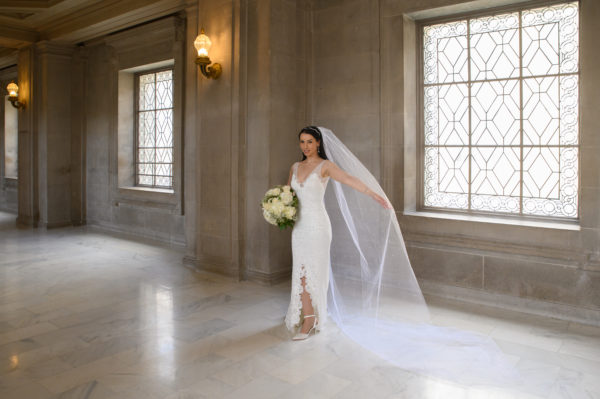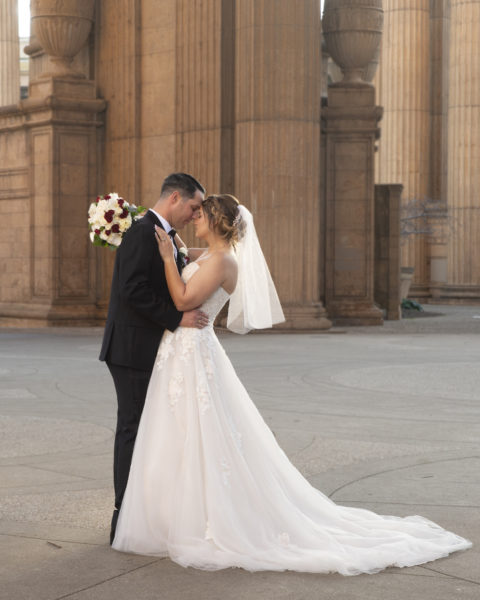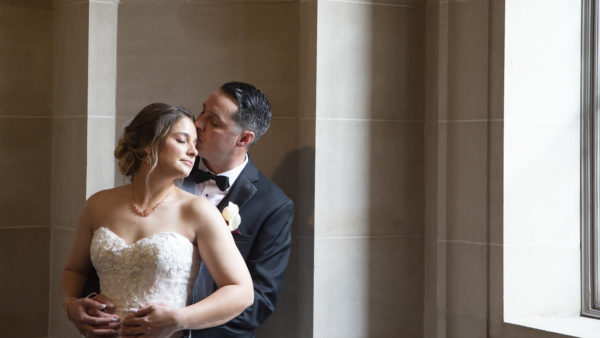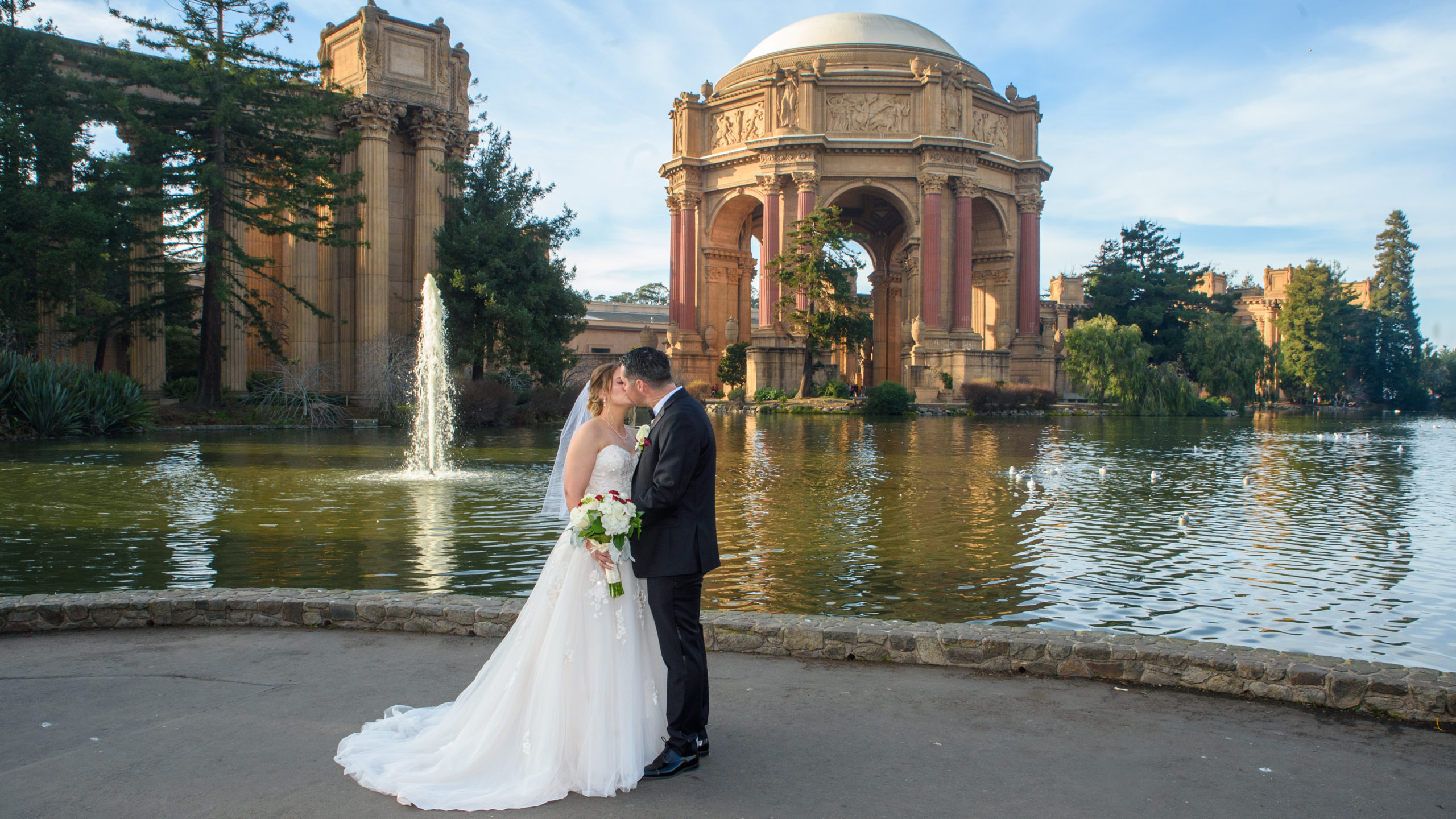Why Post Modern? I believe that we have already gone well beyond the concept of Modern Wedding Photography in 2025. In my opinion, the modern wedding photography era started with the emergence of quality digital professional cameras. As a SF City Hall wedding photographer who has spanned both the film and digital eras, I feel like I can speak with a certain amount of authority on the subject. With over 2,000 weddings photographed, I have still shot more large weddings with film than I have with my Digital cameras! I can certainly say that the differences between the film and digital eras are enormous. I thought it might be fun to explore this in more detail in a blog post. The concepts discussed here mostly to my San Francisco city hall wedding photography specialty, since this is the majority of the work I am currently doing. I will explain more about how some of these concepts apply specifically to SF City Hall weddings as we go on.

Great Wedding Photography – Film Era
OK, so I used to photograph weddings with a medium format 2 1/4 Hasselblad film camera. It was manual focus, manual exposure, and the largest standard film magazine only held 24 exposures. The biggest challenge in those days was getting the exposure right and producing sharp, well composed wedding photos. It took considerable skill and tons of practice to achieve professional level results. In those days, clients were generally pretty happy if you delivered about 500 final photos that were in-focus and nicely posed. If you caught a few special moments, even better! However, this type of camera was not the best for catching candid moments because it took a while to take the picture. Sometimes, by the time you focused and aimed, the moment was over. Many old time wedding photographers used to swear that manually focusing was the only way to go for “real” photography. I was personally more than glad to have this particular aspect of photography taken care of for me for the following reasons…
Back in those days, I also shot with a 35 mm film camera because of its faster speed. This was the camera that I hoped would help me catch moments. However, there was always this special amount of luxury associated with using a 2 1/4 Camera and so most of the professional wedding photographers used them. It was almost as though professionals were expected to use them to set us apart. Looking back, I am not really sure what the huge advantage was. It some ways, I think it was just a status symbol. Obtaining sharp larger format photos was really not such a huge advantage when it came to wedding photography since about 95% of the images taken never were enlarged much beyond 5X7. Having an auto focus camera has so many advantages and still does. Especially when it comes to San Francisco city hall wedding photography. I always wondered about the fascination people had with medium format cameras when it came to wedding photography. The advantages were few.
Hiring of Professional Wedding Photographers Motivated by Fear
There was a certain fear back in those days of hiring a friend or having Uncle Bob shoot your wedding. Why? Because of the horror stories involving amateur photographers delivering blurry photos or no photos at all! The problem with film cameras is that you could have a wrong setting for the whole wedding and not even realize it until the pictures were “developed”! The other challenge oddly enough, was making sure that you didn’t run out of the roll of 24 photos at the wrong time. We could load extra film magazines that would be relatively easy to change once the first roll ran out. Needless to say, you always wanted to start the ceremony with a new roll of film. Even if this meant wasting a few shots to enable a ceremony preload. I remember what a hassle it was to make sure that your 24 photos lasted throughout the ceremony. I think that must be where the name Hassle-blad came from! One thing I can say, I became very adept at loading film quickly. The other less likely bad outcome was loading the camera incorrectly and not have the film advance properly. This even happened to me once!
Brides and Grooms Hired Professionals for Peace of Mind
Back to the prior fear we talked about earlier, even as a professional SF City Hall wedding photographer there is always the fear of a camera malfunction or wrong setting even with modern cameras. With Manual cameras, this fear was well founded. This and other issues were one of the main motivating factors for brides and groom to choose a pro. This fear turned into relief from clients when their wedding photographers were able to deliver 500 + proofs in a nice preview album with printed 5X5 proofs. I am certainly not suggesting that brides and grooms didn’t expect great photos back then. Yes, even then there was always hope for something better than simply “in focus” prints. There has always been different levels of wedding photography excellence and most of us strived to reach that type of success. My point is, the pressure was not as great back then and you would be forgiven if you didn’t produce any truly great shots. This type of mediocre performance would not place you in the elite division of professional wedding photographers. It would allow you to have a career in wedding photography and make a decent living. Not anymore…..
Digital Photography Comes of Age
To avoid boring my audience with a long and tiresome history lesson on Digital Photography, suffice it to say that in the late 90’s, advanced types of digital cameras were starting to become available at affordable prices for the consumer and professionals. For those readers who want more details, here is an excellent digital photography history for your perusal. Exceptional yet affordable digital cameras being made available to the public basically killed the old wedding photography industry as we knew it. The mystery was gone!
Anyone could now take wedding photos and know that they would at least turn out. Professional wedding photographers throughout the San Francisco area and beyond began to see their bookings drop! I actually remember comparing notes with my fellow photographers regarding the number of weddings we had booked for the year. As each year went by, the numbers went down. This was especially true with regard to San Francisco city hall wedding photography since many couples seeking a photographer at this venue are on strict budgets.
Many wedding photographers closed their businesses. There were just not enough weddings to go around for all of us because so many potential clients felt confident in a friend or “Uncle Bob” shooting their wedding with their cool new digital SLRs. Never mind that “Bob” had no back-up system and, at that time, a camera with only one card slot. You were putting a lot of faith in this uncle and there were (and still are) plenty of horror stories associated with this type photographic coverage. Did this amateur friend or relative know how to pose the couple creatively? Did they make back-ups right after the wedding? What do you think?

Surviving the Digital Photography Era – SF City Hall
For a professional wedding photographer to survive in what I call the Post Modern era, we had to offer our clients something more. How did we do it? Well, digital photography had one major advantage over film….. You could take all the photos you wanted and it didn’t cost a penny. This allowed pro photographers to take more photos and as a result, produce more candid photos. Thus, Wedding Photojournalism was born! Now we could shoot thousands of photos at every wedding and capture all the special moments and we didn’t have to pay $1.00 for each photo (approximate film era cost per photos was always said to be $1.00 each! This number took into account both the cost of the film and the developing of it). I am convinced that so called photojournalistic wedding photography was born out of the digital camera era.
Books were published about this new phenomenon of Documentary wedding photography. Brides started asking us if our style was traditional or photojournalistic. I could go into a great detail about all of this and perhaps will in a future blog post, but for the purpose of this article suffice it to say that documentary wedding photography was the hot style in the 1st decade of the 21st century. Everyone wanted a “photojournalist” to cover their wedding and many wedding photographers wanted to be that person. In it its simplest form, Photojournalism wasn’t really that hard. Just take 2,000 wedding photos and trust to luck. Chances are, you will get a few great shots. I referred to it as the Machine Gun approach to wedding photography. Just fire away!
This also helped tremendously with San Francisco city hall wedding photography because it gave us a way to combat the tricky lighting there. Bouncing flash off of the walls and shooting into windows all became easier at SF City Hall with digital cameras. Personally, I never completely subscribed to the rapid fire approach to wedding photography, but I definitely took advantage of no cost picture taking and it helped elevate the quality of my pictures. It allowed all of us to “push the envelope”.
Death of the Wedding Photojournalist
What I am about to write will be somewhat controversial among some of my fellow SF city hall wedding photographers. It is my opinion that after a decade marked by thousands of brides having their weddings covered in a purely documentary style, the results were a considerable disappointment among many clients. As it turned out, it really wasn’t that difficult to take 2,000 photos at a wedding and catch dozens of “moments.” In fact, armed with a fully automatic digital camera and about 1 hour of training, virtually anyone could be a wedding photojournalist as was defined in that era. I think it is fair to point out, however, that many Documentary style photographers rose above the simplicity of taking rapid fire photos throughout an 8 hour wedding coverage. I can name quite a few, that used this style to excel and truly offer their brides and grooms amazing and artistic wedding photos. But for every 1 of these types of exceptional photographers, there were probably about 10 rapid fire shooters. Most of these rapid fire shooters are now extinct.
Unfortunately, this ease of entry into the business allowed hundreds of wedding photographers to become part of the industry with no knowledge of lighting or posing. This was especially true at San Francisco city hall because of the fact that many weddings here were low budget weddings and people wanted to save money if possible. Clients soon grew tired of having to wade through thousands of candid wedding photos with no images really standing out. Did the wedding photographer capture some great moments? Of course they did! But how were the family photos, how was the lighting, were there any fun poses? Was there any drama in the final results, and images with impact? Too often the answer was no!
Wedding Photography as Art at SF City Hall and Beyond
I believe that the post modern era of wedding photography began in the early part of this decade (2010). It’s emergence was gradual yet definitive. We began to approach wedding photography as an art form and not just an assignment. This also included San Francisco city hall wedding photographers such as myself. In fact, we even started calling ourselves artists! Randomly check out some professional wedding photographer’s websites and you will see that many people have changed the “About” section to “About the Artist”. Many now refer to wedding packages as “Collections”. If you could still see wedding photography websites from the film era you would not see any of this terminology. Back then we were described as “shooters” or simply “picture takers.”
To stand out in the post modern era, superior SF city hall wedding photographers need to provide their clients with creative photos with beautiful light and gorgeous backgrounds. The posing needs to be correctly done and grab the viewer’s attention. Do these attributes sound familiar? Of course, it’s some of the same things you hear about other forms of art such as paintings. Even Pinterest has collections of wedding photos called Fine Art Wedding Photography . This is one of the new names for us… Fine Art wedding photographers! In my case, I would like to think of it as Fine Art San Francisco city hall wedding photographers! No matter what your specialty, this relatively new association with art is now part of the landscape and we all welcome it.
The Post Modern Wedding Photographer at SF City Hall
If you aspire to be a professional wedding photographer whether you want to specialize in SF city hall or weekend weddings, you will need to be able to produce creative images with impact and beauty. In this new era of Post Modern wedding photography, these skills are necessary to be competitive. You will also need to understand lighting, composition and posing. Machine gun candid photo shooters are still out there, but they will not be considered in the upper echelons nor will they command top dollar for their work. In a sense, the industry has come full circle.
This could not be more relevant for city hall wedding photographers also. We have very much benefited from the new technology and it has pushed us to create true art at this historic building. As was true in the film era, a successful wedding photographer will need to possess great skill, but with a difference… The old Technical skill needed to operate ancient film cameras has now been replaced by the skill of an artist!
Update: With AI technology here to stay, camera equipment has become even less important. In fact, I would venture to say it’s a waste of money to spend thousands of dollars on a more expensive digital camera when you can fix everything during post processing so easily using AI. One example of this is the race for the most megapixels in camera equipment. AI technology now allows us to double or triple the file size of our images with no loss in quality. I have done side-by-side tests and no one can tell the difference. In addition, with the new noise reduction software now available you can fix just about any image and make it look great. So upgrading your camera to get less noise with high iso settings is not nearly as important as it used to be!

